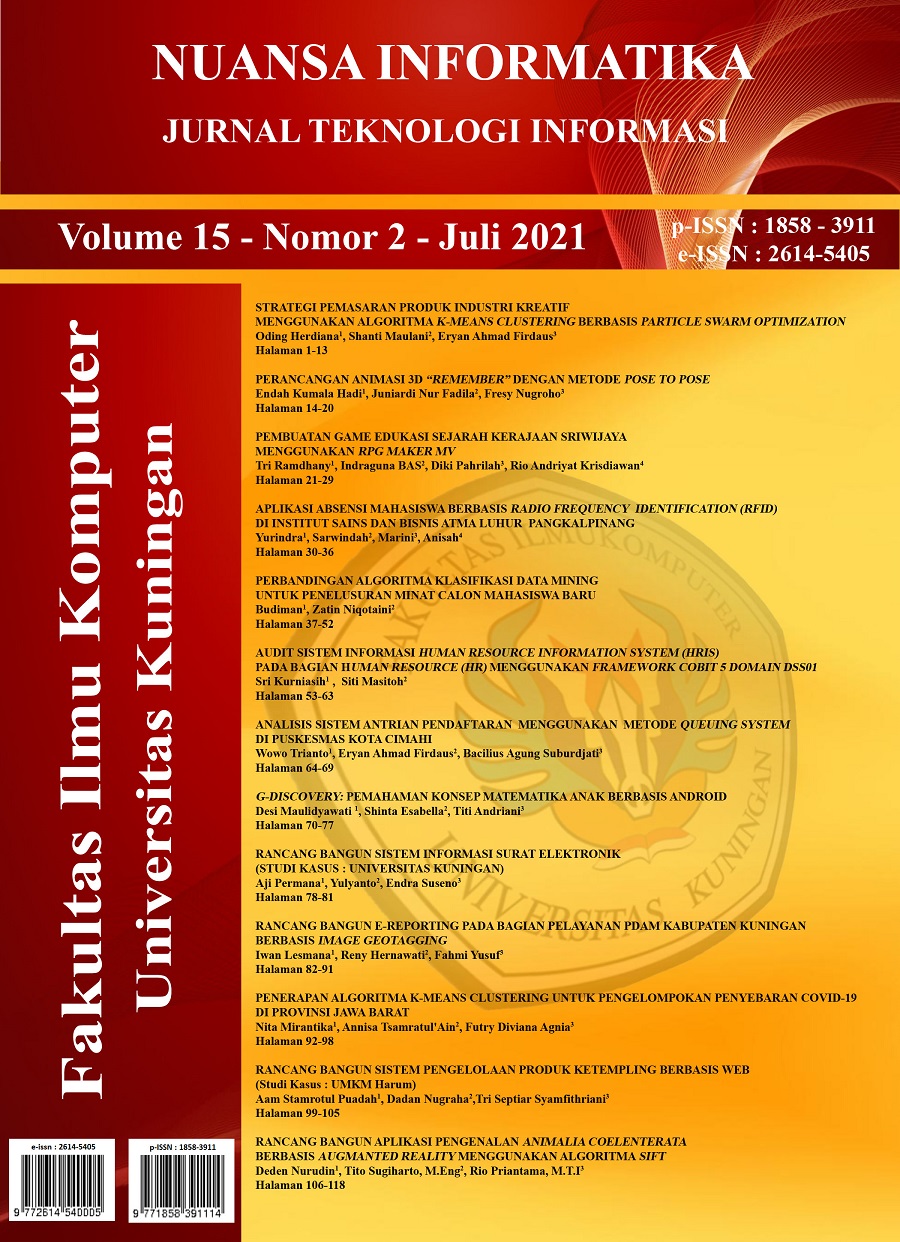Perbandingan Algoritma Klasifikasi Data Mining untuk Penelusuran Minat Calon Mahasiswa Baru
Abstract
During the AMIK HASS pandemic, it was difficult to determine new student candidates. So that to attract public interest, the Marketing Department has implemented several strategies to attract prospective students to become new students. The data mining technique used in predicting is a classification that includes Naïve Bayes, J48 Decision Tree, and K-Nearest Neighbor. This study aims to perform a comparative analysis of data mining classification algorithms using WEKA tools. The method used in this study, using CRISP-DM. The dataset used by the three classifications is 5,934 records with split mode, the percentage of testing is 70% as much as 4154 as training data and 30% as much as 1780 data as test data. Based on the test results on the three classification models, the highest accuracy value is obtained in the J48 Decision Tree classification, which has a value of 90.3%. While the K-Nearest Neighbor classification has a lower accuracy of 87.52% and the Naïve Bayes classification has an accuracy of 87.24%. The comparison of the AUROC J48 Decision Tree test results has the highest value of 0.9654 while the Naïve Bayes results are 0.9461 and the K-Nearest Neighbor results are 0.9343. The three classifications with ABK scores above 0.90 are included in the excellent classification category
References
R. Setiawan, Aug. 2016, Penerapan Data Mining Menggunakan Algoritma K-Means Clustering untuk Menentukan Strategi Promosi Mahasiswa Baru (Studi Kasus : Politeknik Lp3i Jakarta), J. LENTERA ICT, vol. 3, no. 1, pp. 76–92, Accessed: Feb. 25, 2021. [Online]. Available: https://plj.ac.id/ojs/index.php/jrict/article/view/27.
N. Yahya and A. Jananto, 2019, Komparasi Kinerja Algoritma C.45 dan Naive Bayes untuk Prediksi Kegiatan Penerimaan Mahasiswa Baru (Studi Kasus : Universitas STIKUBANK Semarang), in Prosiding SENDI_U, pp. 221–228, Accessed: Mar. 08, 2021. [Online]. Available: https://www.unisbank.ac.id/ojs/index.php/sendi_u/article/view/7389.
V. Raj and S. K. Manivannan, 2020, Predicting Student Failure in University Examination using Machine Learning Algorithms, Int. J. Innov. Technol. Explor. Eng., vol. 9, no. 5, pp. 956–959, doi: 10.35940/ijitee.E2643.039520.
E. A. Baruah, S. Baruah, and J. Goswami, 2020, A Comparative Analysis of Different Classification Algorithms based on Students’ Academic Performance Using WEKA, IOSR J. Comput. Eng., vol. 22, no. 1, pp. 49–56, doi: 10.9790/0661-2201024956.
Nidhi, M. Kumar, N. Nayar, and G. Mehta, 2020, Student’s Academic Performance Prediction in Academic using Data Mining Techniques, in 1st International Conference on Intelligent Communication and Computational Research (ICICCR-2020), pp. 1–5, Accessed: Mar. 08, 2021. [Online]. Available: https://ssrn.com/abstract=3565874.
S. Widaningsih, Apr. 2019, Komparasi Kinerja Algoritma C.45 dan Naive Bayes untuk Prediksi Kegiatan Penerimaan Mahasiswa Baru (Studi Kasus : Universitas STIKUBANK Semarang), J. Tekno Insentif, vol. 13, no. 1, pp. 16–25, doi: 10.36787/jti.v13i1.78.
A. Azahari, Y. Yulindawati, D. Rosita, and S. Mallala, May 2020, Komparasi Data Mining Naive Bayes dan Neural Network memprediksi Masa Studi Mahasiswa S1, J. Teknol. Inf. dan Ilmu Komput., vol. 7, no. 3, pp. 443–452, doi: 10.25126/jtiik.2020732093.
S. Linawati, R. A. Safitri, A. R. Alfiyan, W. E. Pangesti, and M. N. Winnarto, Mar. 2020, Perbandingan Algoritma Klasifikasi Naive Bayes dan SVM Pada Studi Kasus Pemberian Penerima Beasiswa PPA, Swabumi, vol. 8, no. 1, pp. 71–75, doi: 10.31294/swabumi.v8i1.7708.
Hermanto, A. Mustopa, and A. Y. Kuntoro, Feb. 2020, Algoritma Klasifikasi Naive Bayes dan Support Vector Machine dalam Layanan Komplain Mahasiswa, JITK (Jurnal Ilmu Pengetah. dan Teknol. Komputer), vol. 5, no. 2, pp. 211–220, doi: 10.33480/jitk.v5i2.1181.
B. Budiman, R. Nursyanti, R. Y. R. Alamsyah, and I. Akbar, Sep. 2020, Data Mining Implementation Using Naïve Bayes Algorithm and Decision Tree J48 In Determining Concentration Selection, Int. J. Quant. Res. Model., vol. 1, no. 3, pp. 123–134, doi: 10.46336/ijqrm.v1i3.72.
D. T. Larose and C. D. Larose, 2015, Data Mining and Predictive Analytics. Hoboken, New Jersey: John Wiley & Sons, Inc.
E. Sabna and M. Muhardi, 2016, Penerapan Data Mining Untuk Memprediksi Prestasi Akademik Mahasiswa Berdasarkan Dosen, Motivasi, Kedisiplinan, Ekonomi, dan Hasil Belajar, J. CoreIT J. Has. Penelit. Ilmu Komput. dan Teknol. Inf., vol. 2, no. 2, p. 41, doi: 10.24014/coreit.v2i2.2392.
D. Astuti, A. R. Iskandar, and A. Febrianti, May 2019, Penentuan Strategi Promosi Usaha Mikro Kecil Dan Menengah (UMKM) Menggunakan Metode CRISP-DM dengan Algoritma K-Means Clustering, J. Informatics, Inf. Syst. Softw. Eng. Appl., vol. 1, no. 2, pp. 60–72, doi: 10.20895/inista.v1i2.71.
P. Hari Santoso, May 2020, Application of Data Mining Classification for Covid-19 Infected Status Using Algortima Naïve Method, J. Mantik, vol. 4, no. 36, pp. 267–275, Accessed: Apr. 11, 2021. [Online]. Available: https://iocscience.org/ejournal/index.php/mantik/index.
M. F. Maulana and M. Defriani, Mar. 2020, Logistic Model Tree and Decision Tree J48 Algorithms for Predicting the Length of Study Period, PIKSEL Penelit. Ilmu Komput. Sist. Embed. Log., vol. 8, no. 1, pp. 39–48, doi: 10.33558/piksel.v8i1.2018.
S. Khruahong and P. Tadkerd, Oct. 2020, Analysis of Scholarship Consideration Using J48 Decision Tree Algorithm for Data Mining, in International Conference on Cooperative Design, Visualization and Engineering, vol. 12341, pp. 230–238, doi: 10.1007/978-3-030-60816-3_26.
M. Kück and M. Freitag, Jan. 2021, Forecasting of Customer Demands for Production Planning by Local K-Nearest Neighbor Models, Int. J. Prod. Econ., vol. 231, p. 107837, doi: 10.1016/j.ijpe.2020.107837.
H. Tang et al., 2020, Predicting Green Consumption Behaviors of Students Using Efficient Firefly Grey Wolf-Assisted K-Nearest Neighbor Classifiers, IEEE Access, vol. 8, pp. 35546–35562, doi: 10.1109/ACCESS.2020.2973763.
F. Gorunescu, 2011, Data Mining: Concepts, Models and Techniques. Berlin: Springer-Verlag Berlin Heidelberg.
Suwarno and A. Abdillah, 2016, Penerapan Algoritma Bayesian Regularization Backpropagation Untuk Memprediksi Penyakit Diabetes, J. MIPA, vol. 39, no. 2, pp. 150–158, Accessed: Mar. 16, 2021. [Online]. Available: http://journal.unnes.ac.id/nju/index.php/JM.

